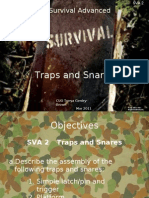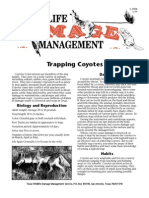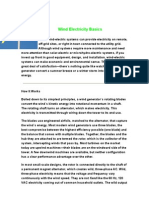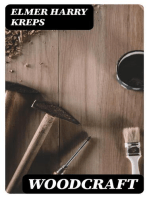Setting Snares
Setting Snares
Uploaded by
xxxrainbowxxxCopyright:
Available Formats
Setting Snares
Setting Snares
Uploaded by
xxxrainbowxxxOriginal Description:
Original Title
Copyright
Available Formats
Share this document
Did you find this document useful?
Is this content inappropriate?
Copyright:
Available Formats
Setting Snares
Setting Snares
Uploaded by
xxxrainbowxxxCopyright:
Available Formats
Setting Snares
To set a snare, the looped end of the snare is suspended over a trail or path that the animal is expected to use. The animal enters the snare, sticking its head through the loop, and through its forward progress draws the snare down on itself. It should be noted, that not all animals are snared by catching them around the neck. You will be more successful snaring some animals like raccoon and beaver if the snare cinches up on their body somewhere behind one or both of their front legs. These animals both have a short, rounded head and a great deal of manual dexterity with their front feet. Using their front paws, these animals can often slip a snare off over their head. Other animals, most notably canines, have a long tapered head that is very wide just behind their ears. When a snare closes on their neck it is very unlikely they will be able to slip out of it or remove it. In this case, it is better to snare these animals by the neck. There are two major considerations in setting a snare to target a specific animal the size of the loop and the distance from the bottom of the loop to the ground. In making these determinations you must consider the size of the animal, the height of the animals head above the ground (generally determined by the length of its legs) and whether it is best to catch the animal by the neck or by the body. For an animal you want to snare by the neck, the snare loop should be just large enough to admit the animals head. The snare should be positioned so that the bottom of the loop strikes the animals chest at the base of the neck after its head goes through the loop. To snare an animal by the body, you need a loop big enough to admit the front portion of the animals body. The loop must be low enough to the ground so that the animal can step through it, but high enough to strike the animals chest after the animal steps through the snare.
In snaring canines the snare is positioned to catch the animal around the neck. The loop should be large enough to comfortably admit the animal's head. It should be positioned low enough to clear the animal's chin, but high enough so the animal does not step through it.
Raccoon and beaver have a great deal of dexterity with their front paws and can often slip a snare off their neck. These animals are more successfully snared around the body. The snare loop should be large enough to admit the front portion of the animal's body and positioned low enough so the animal can step one or both front legs through the loop.
Ohio Snaring Guide - 19
Loop Sizes and Heights for Furbearers
BEAVER (Swimming) Loop 9" to 10" Height 1/3 above water 2/3 below water
20 - Ohio Snaring Guide
Avoiding Deer and Livestock
While your snares will be set to take furbearing animals, the possibility exists that larger animals, like deer or livestock could get tangled up in your snare. This usually happens when the animal is walking along and gets its foot through the snare loop. Some of the Ohio regulations are designed to deal with this problem. Snares, or any other trapping devices, cannot be set in paths commonly used by humans or domestic animals. This means snares cannot be set in active livestock trails. In regards to deer, Ohio snares must employ one of two features. One option is to install a stop on the cable that prevents the loop from closing past a diameter of 2-1/2 inches. This would allow a deer to shake the snare off its foot. The other option is to use a lock or lock system that will break away from the snare cable at 350 pounds or less. This would allow a deer to break the lock as it pulls against the snare. These regulations are designed to minimize the potential for detaining a large animal in your snare. Still the best way to avoid deer and livestock is to avoid setting your snares where these animals are likely to be encountered. You should not set snares within the confines of a pasture where livestock is present. Deer are free roaming, wild animals, but you can take measures to avoid catching them in your snares. Do not set snares on trails that show frequent or heavy use by deer. There are other instances when you may want to set a snare on a trail that is not regularly used by deer, but still the possibility exists that a deer might take that trail. In this case, you can construct the set to make the deer avoid your snare. The best way to do this is to place a pole over your snare. The pole should be about the size of your wrist or larger. You can place the pole horizontally over your snare and support it on each end. This gives the appearance of the goal posts on a football field. With the pole just above the snare, the deer will jump or step over the pole, while the target animal will go under the pole and into the snare. Another option is to use a leaning pole to steer the deer away from your snare. This is best accomplished where the trail passes close to a tree and the snare is fastened to the tree. Here, you can lean a pole against the tree at an angle with the snare between the pole and the tree. A deer will walk around the outside of the pole and avoid the snare. Make sure there is room on the outside of the pole for the deer to detour around it. In each of these cases, the pole should be propped up so that it will not fall down easily. However, the pole should not be wired or permanently fastened in place because it could create an entanglement situation for the animal. The animal should be able to knock the pole over if it gets the snare around it.
Do not set snares in the confines of a pasture where livestock is present.
Ohio Snaring Guide - 21
Avoid setting snares in trails that show heavy use by deer. In trails that do not show deer activity but might be used by a deer at some time, you can set up objects that will guide the deer away from your snare. Here a pole is leaned against the tree to make the deer step off to one side. In using this method, make sure there is room on the outside of the pole for the deer to pass.
Here a pole is laid horizontally over the snare. If a deer encounters this pole, it will jump over the pole and miss the snare. This is sometimes called a "jump pole". Do not fasten these poles in place too solidly, or they may create an entanglement situation. An animal caught in the snare should be able to knock these poles down.
22 - Ohio Snaring Guide
Sets with Snares
Snaring requires a minimum amount of equipment for constructing sets. You need snares, wire with which to fasten and stabilize the snares, and pliers for cutting and twisting the wire. You will also need stakes and a hammer if you are going to fasten your snares this way. Another tool that you may need is a set of cable cutters. These cutters are specially designed to cut steel cable. It is nearly impossible to cut this cable with any type of regular pliers. While other trapping devices, like foothold and bodygrip traps, can be used over and over again to catch animals, snares can be used only once. After an animal has been held in the snare, the cable will be bent and twisted, and the snare will no longer function properly. It is possible to use the hardware from the snare, like the lock and swivel, and make another snare using a new piece of cable, ferrules, and deer stop if necessary. Snares and snare components are available from trapping supply dealers. The principles for constructing a set with a snare are somewhat different than those often applied with other trapping devices. Often trappers use bait or lure to get an animal to stop where the trap is set. Snares depend on an animals continued forward progress to tighten down the snare loop. A set with a snare is basically a trail or blind set. You should not use lure or bait in close proximity of your snare or use anything else that would make an animal stop or hesitate as it approaches and enters the snare. The following are examples of sets that can be made with snares. For these depictions, the snares have been painted white to make them easier for you to see. In actual practice, you would not use a white snare unless you were trapping in snow. To remove the shine from new snares and make them less visible, boil the snares for about a half-hour in a baking soda solution.
Snaring does not require a lot of equipment. You need snares, a roll of wire for fastening and stabilizing your snares, and pliers for cutting and bending the wire.
If you are going to do much snaring, you should invest in a set of cable cutters. These will cut snare cable quickly and cleanly. It is very difficult to cut snare cable with regular pliers.
Ohio Snaring Guide - 23
Here is a snare set for coyote. The coyotes are going under a fence that is in the background. The snare has been set away from the fence at the edge of the tall grass. The snare is staked far enough away from the fence that any animal caught in it will not be able to reach the fence.
Here is a set for fox made in the woods on a trail. A pole has been leaned over the snare in case a deer comes down the trail. There is nothing within reach of the snare for the animal to tangle up on.
This snare is set for coon where the animals have made a trail through tall grass. There is no entanglement here and no danger of an animal being harmed by the snare.
24 - Ohio Snaring Guide
Here is a snare set for beaver where the animals are climbing up over a creek bank. This is a clear area with no entanglement.
You might also like
- From The Grave The Arcana Chro Kresley ColeDocument322 pagesFrom The Grave The Arcana Chro Kresley ColeВикк Жамова100% (1)
- The PDR For Herbal MedicinesDocument1,109 pagesThe PDR For Herbal Medicinesxxxrainbowxxx96% (54)
- A Step-By-Step Guide To Building An EMP Resistant Solar Survival GeneratorDocument51 pagesA Step-By-Step Guide To Building An EMP Resistant Solar Survival GeneratorvaleNo ratings yet
- Practical Emergency Preparedness: Recommended Steps To Developing Your Own PlanDocument24 pagesPractical Emergency Preparedness: Recommended Steps To Developing Your Own PlanjacobNo ratings yet
- Boomer Guide To PreppingDocument16 pagesBoomer Guide To Preppingrickoshea160100% (1)
- Commando Toggle RopeDocument4 pagesCommando Toggle RopeTokatuuNo ratings yet
- 100 Free Survival Downloads - SurvivalDocument12 pages100 Free Survival Downloads - Survivalkurdapio100% (4)
- Modern Meds StockpileDocument60 pagesModern Meds StockpileMaria Brickhouse100% (1)
- Botanical MedicineDocument202 pagesBotanical MedicineJeff Radford100% (47)
- A1 There Was An Old Lady Who Swallowed A FlyDocument1 pageA1 There Was An Old Lady Who Swallowed A FlyEvaNo ratings yet
- Ch. 1 Because of Winn DixieDocument9 pagesCh. 1 Because of Winn DixieKevin Jones100% (1)
- How To Make Animal Traps PDFDocument3 pagesHow To Make Animal Traps PDFGreen MeisterNo ratings yet
- Deadfalls And Snares - A Book Of Instruction For Trappers About These And Other Home-Made TrapsFrom EverandDeadfalls And Snares - A Book Of Instruction For Trappers About These And Other Home-Made TrapsNo ratings yet
- Living Off Grid (Brooks Solar)Document5 pagesLiving Off Grid (Brooks Solar)DryadwoodsNo ratings yet
- Survival AntibioticsDocument4 pagesSurvival Antibioticssuasponte2No ratings yet
- Rabbit ProcessingDocument4 pagesRabbit Processingmary_burnetteNo ratings yet
- Preserving Herbs 3 WaysDocument3 pagesPreserving Herbs 3 WaysharleyNo ratings yet
- Guide To Wild-Harvested Mushrooms and Spring Greens: The Morel Is One The Most Popular andDocument7 pagesGuide To Wild-Harvested Mushrooms and Spring Greens: The Morel Is One The Most Popular andO.L.D.E.No ratings yet
- Survival Drinking Water Guide (Guide # 3 of 20)Document30 pagesSurvival Drinking Water Guide (Guide # 3 of 20)SURVIVALKEY100% (2)
- Household Items With First Aid UsesDocument20 pagesHousehold Items With First Aid UsesOngwehonwehNo ratings yet
- Outdoor Survival 33 Edible Wild Plants and HerbsDocument39 pagesOutdoor Survival 33 Edible Wild Plants and HerbsMario ZajaNo ratings yet
- Quail-Farming-For-Beginner GuideDocument12 pagesQuail-Farming-For-Beginner GuideEnittah Ith Chikuse0% (1)
- Deer Feeder Ebook: Discovering The Benefits of Using Game FeedersDocument14 pagesDeer Feeder Ebook: Discovering The Benefits of Using Game FeedersAnne de CeuninckNo ratings yet
- 3 Ways To Make A Survival Fish TrapDocument9 pages3 Ways To Make A Survival Fish TrapTim WeigelNo ratings yet
- Tomatoes - Organic Growing Guides For Teachers + Students + SchoolsDocument1 pageTomatoes - Organic Growing Guides For Teachers + Students + SchoolsOrganic Growing Guides - One Pot PledgeNo ratings yet
- Be Ready For Nuclear Attack Final VersionDocument30 pagesBe Ready For Nuclear Attack Final Versionvale100% (1)
- Garden BugsDocument12 pagesGarden BugsDHOBONo ratings yet
- Survival Traps and Snares Squadron 110321031416 Phpapp01Document36 pagesSurvival Traps and Snares Squadron 110321031416 Phpapp01Bruno Almeida67% (3)
- Coyotes 10Document4 pagesCoyotes 10bdburnettNo ratings yet
- How To Fish Freshwater Fishing Kit E BookDocument26 pagesHow To Fish Freshwater Fishing Kit E BookEngkong MiftahNo ratings yet
- Easy Home Solar PowerDocument20 pagesEasy Home Solar PowerAhmed SharifNo ratings yet
- What Is A 72 Hour Kit?Document12 pagesWhat Is A 72 Hour Kit?Alexandros KatsonisNo ratings yet
- Skills You Need To Learn Bushcraft Survival Skills ChecklistDocument4 pagesSkills You Need To Learn Bushcraft Survival Skills ChecklistAgustin PeraltaNo ratings yet
- How To Butcher A Homestead-Raised Hog - Mother Earth NewsDocument1 pageHow To Butcher A Homestead-Raised Hog - Mother Earth NewsMassimo RiserboNo ratings yet
- What If They Tell You To EvacuateDocument14 pagesWhat If They Tell You To EvacuateshivadogNo ratings yet
- Pelt HandlingDocument28 pagesPelt HandlingRalf Snell0% (1)
- 50 High Value Items To Stockpile For When SHTF - Ask A PrepperDocument7 pages50 High Value Items To Stockpile For When SHTF - Ask A Prepperalbert wilson100% (3)
- Field To FreezerDocument34 pagesField To FreezerSid ZorkNo ratings yet
- 100 Items To Disappear FirstDocument14 pages100 Items To Disappear Firstadamc73100% (4)
- FREE DIY Survival KitDocument3 pagesFREE DIY Survival KitMSavicNo ratings yet
- Wind Electricity BasicsDocument17 pagesWind Electricity Basicssebascian100% (2)
- Root Cellar PlansDocument8 pagesRoot Cellar PlansTin Bell100% (1)
- 100-Year-Old Way To Filter Rainwater in A Barrel - The Prepper JournalDocument5 pages100-Year-Old Way To Filter Rainwater in A Barrel - The Prepper JournalKen100% (2)
- 15 Explosive Recipes For Preppers - PrepperFortressDocument10 pages15 Explosive Recipes For Preppers - PrepperFortressRoddy PfeifferNo ratings yet
- How To Outlive An EMP The Early Pioneer Way - Claude DavisDocument24 pagesHow To Outlive An EMP The Early Pioneer Way - Claude DavisMattNo ratings yet
- Diy Wind TurbineDocument9 pagesDiy Wind TurbineatoydequitNo ratings yet
- Composting and Worm Farming: Nature's Recycling SystemDocument8 pagesComposting and Worm Farming: Nature's Recycling SystemGreater Charlotte Harbor Sierra ClubNo ratings yet
- Survival Skills Your Child Should KnowDocument2 pagesSurvival Skills Your Child Should KnowSherryNo ratings yet
- DIY MRE'sDocument9 pagesDIY MRE'sAnonymous MyUcfoNo ratings yet
- Alcohol StoveDocument8 pagesAlcohol StovecagedraptorNo ratings yet
- Tapping Birch: Collecting Birch Sap For Mineral Water, Wine, Beer, Vinegar and SyrupDocument12 pagesTapping Birch: Collecting Birch Sap For Mineral Water, Wine, Beer, Vinegar and SyrupMHavocNo ratings yet
- 207 Bushcraft and Indigenous Knowledge Transformations of A Concept in The MDocument320 pages207 Bushcraft and Indigenous Knowledge Transformations of A Concept in The MCaroline BirkoffNo ratings yet
- A Guide To Preserving EggsDocument16 pagesA Guide To Preserving Eggslestat42100% (1)
- How To Grow Your Own SHTF PharmacyDocument23 pagesHow To Grow Your Own SHTF PharmacyLes BennettNo ratings yet
- Kazakh YurtDocument11 pagesKazakh Yurtreducto osamuNo ratings yet
- The Emergency Food Buyer S Guide V10Document0 pagesThe Emergency Food Buyer S Guide V10grelfod100% (2)
- Vehicle Bug Out Tote ChecklistDocument1 pageVehicle Bug Out Tote ChecklistDavidNo ratings yet
- Mother Earth News Fence ChargerDocument8 pagesMother Earth News Fence Chargermjohnson52048No ratings yet
- The Ultimate Beginner’s Guide to Homestead Gardening: Your Next Step to Self-SufficiencyFrom EverandThe Ultimate Beginner’s Guide to Homestead Gardening: Your Next Step to Self-SufficiencyNo ratings yet
- The Prepper's Ultimate Forager's Bible - Identify, Harvest, and Prepare Edible Wild Plants to Be Ready Even in the Most Critical SituationFrom EverandThe Prepper's Ultimate Forager's Bible - Identify, Harvest, and Prepare Edible Wild Plants to Be Ready Even in the Most Critical SituationRating: 5 out of 5 stars5/5 (1)
- The Art of Preserving Game Birds and Big Game: A Little Book Full of All the Information You NeedFrom EverandThe Art of Preserving Game Birds and Big Game: A Little Book Full of All the Information You NeedNo ratings yet
- The Ultimate Survival Manual: An Amazing Guide On How to Prepare Yourself To Survive FloodingFrom EverandThe Ultimate Survival Manual: An Amazing Guide On How to Prepare Yourself To Survive FloodingNo ratings yet
- The Shtf Stockpile: 23 Items That Will Help You Remain Alive When Disaster Knocks on Your DoorFrom EverandThe Shtf Stockpile: 23 Items That Will Help You Remain Alive When Disaster Knocks on Your DoorNo ratings yet
- How To Make TrapsDocument4 pagesHow To Make TrapsRichard Pagcaliwagan SantillanNo ratings yet
- ArcanòlgògògòaglguDocument183 pagesArcanòlgògògòaglguxxxrainbowxxxNo ratings yet
- Marketing Manual For Organic Spices Culinary Herbs Essential OilsDocument60 pagesMarketing Manual For Organic Spices Culinary Herbs Essential OilsxxxrainbowxxxNo ratings yet
- Permaculture Self Sustainability NetworkDocument204 pagesPermaculture Self Sustainability Networkxxxrainbowxxx100% (1)
- Encyclopedia of Mind Enhancing Foods, Drugs and Nutritional SubstancesDocument56 pagesEncyclopedia of Mind Enhancing Foods, Drugs and Nutritional SubstancesNephilimJay100% (2)
- Med PlantsDocument104 pagesMed Plantsxxxrainbowxxx100% (1)
- Medicinal PlantsDocument151 pagesMedicinal Plantsallanquartermaine0% (1)
- Wild Edibles Nutrition MedicineDocument29 pagesWild Edibles Nutrition MedicinexxxrainbowxxxNo ratings yet
- Permaculture Cooperation Climate Change and Peak DebtDocument165 pagesPermaculture Cooperation Climate Change and Peak Debtxxxrainbowxxx100% (1)
- How To Make Gold and Silver SolutionsDocument2 pagesHow To Make Gold and Silver SolutionsxxxrainbowxxxNo ratings yet
- How To Make Gold and Silver SolutionsDocument2 pagesHow To Make Gold and Silver SolutionsxxxrainbowxxxNo ratings yet
- PDC Cert BookDocument76 pagesPDC Cert Bookmdoll100% (7)
- LKPD SMP Bahasa Inggris Pertemuan 7Document2 pagesLKPD SMP Bahasa Inggris Pertemuan 7Irga Hardianto100% (1)
- Latihan Soal Kelas 8Document3 pagesLatihan Soal Kelas 8melaNo ratings yet
- Dog Population ControlDocument17 pagesDog Population ControlhNo ratings yet
- Team 5 - Writing NextDocument25 pagesTeam 5 - Writing NextMERI CAHYANINo ratings yet
- College Level Compare and Contrast Essay TopicsDocument5 pagesCollege Level Compare and Contrast Essay Topicsafabfoilz100% (2)
- English Class 1Document25 pagesEnglish Class 1Dinesh KagNo ratings yet
- Gibbon Communication Page 2Document1 pageGibbon Communication Page 2Jenny KyrtsiNo ratings yet
- Bal Vatika3 Syllabus 202425Document12 pagesBal Vatika3 Syllabus 202425Hridiman RajbongshiNo ratings yet
- Elephant and His FriendsDocument3 pagesElephant and His Friendslrc.smpitNo ratings yet
- Y1 English Listening (Pet Show)Document7 pagesY1 English Listening (Pet Show)vikneswaranNo ratings yet
- Classifying Animals: Strand Topic Primary SOL 1.5Document5 pagesClassifying Animals: Strand Topic Primary SOL 1.5Yoregeff DaiunNo ratings yet
- Filipino Paper 5Document4 pagesFilipino Paper 5IqbalNo ratings yet
- Class-3 English ExercisesDocument35 pagesClass-3 English ExercisesAvni MalviyaNo ratings yet
- Assignment 3Document7 pagesAssignment 3Maria Virginia VirayNo ratings yet
- Races of HyruleDocument99 pagesRaces of HyruleScrindlemorpNo ratings yet
- Top 20 Dangerous Dog Breed in The WorldDocument6 pagesTop 20 Dangerous Dog Breed in The WorldShahan GhummanNo ratings yet
- NGK Ultimate DinopediaDocument19 pagesNGK Ultimate DinopediaIleana VelázquezNo ratings yet
- Psychometric Properties of The Lexington Attachment To Pets Scale: Mexican Version (LAPS-M)Document9 pagesPsychometric Properties of The Lexington Attachment To Pets Scale: Mexican Version (LAPS-M)Krishnapriya T SNo ratings yet
- Change of Owner Details C3A FormDocument2 pagesChange of Owner Details C3A FormcalebderneddeNo ratings yet
- Soal Report Text Kunci JawabanDocument12 pagesSoal Report Text Kunci JawabanIndah SafitriNo ratings yet
- Phylum ChordataDocument20 pagesPhylum ChordataXue Hui KhooNo ratings yet
- DLP English 4 Q4 Fact and Opinion DLRC DemoDocument6 pagesDLP English 4 Q4 Fact and Opinion DLRC DemoKarluen Fatima PlandoNo ratings yet
- المهام الادائية - كونكت - 6 ب - ت 1 - ذاكروليDocument29 pagesالمهام الادائية - كونكت - 6 ب - ت 1 - ذاكروليzeindeyaa2No ratings yet
- Frailled SharkDocument8 pagesFrailled SharkAntonio Acaylar, Jr.No ratings yet
- The English LessonDocument2 pagesThe English LessonLeony GuedesNo ratings yet
- THE LEAST HARM PRINCIPLE-veganDocument8 pagesTHE LEAST HARM PRINCIPLE-veganrobert.cesarNo ratings yet
- Англійська 5кл Карпюк 2013Document280 pagesАнглійська 5кл Карпюк 2013vesnikNo ratings yet





































































































